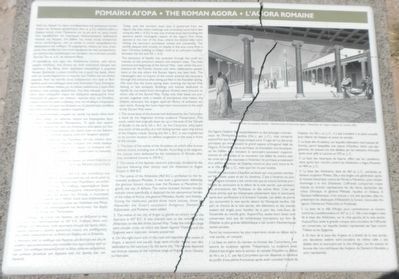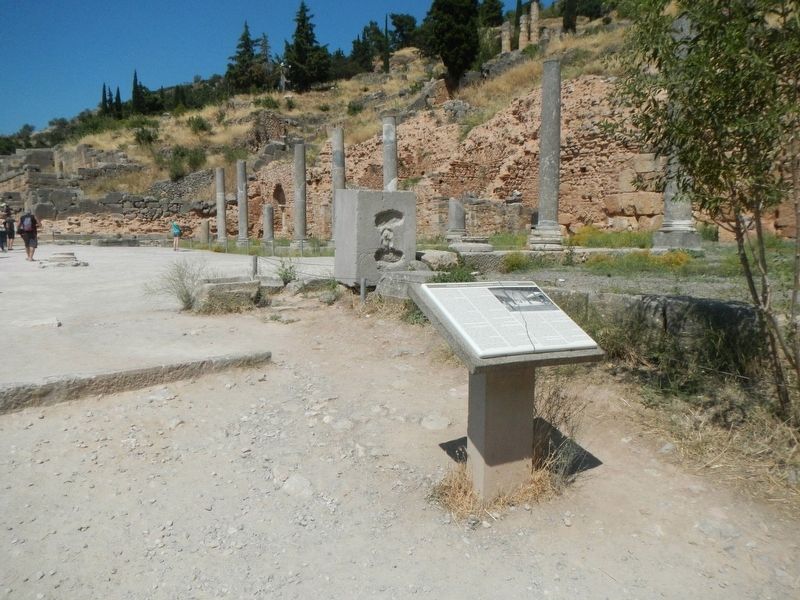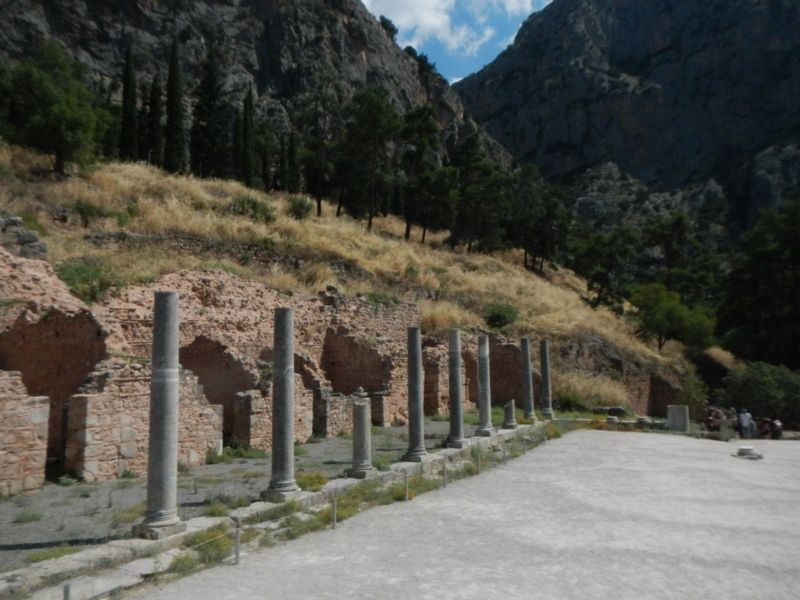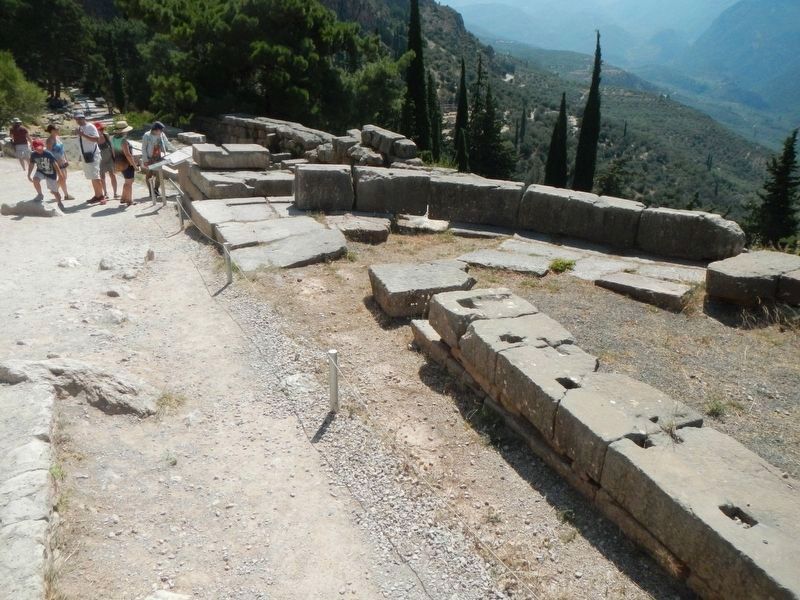Delfi in Phocis, Thessaly and Central Greece, Greece — Ελλάδα (Southeastern Europe, Balkan Peninsula)
The Roman Agora
PΩMAΪKH AΓOPA
— L'Agora Romaine —
English:
Today, only the northern Ionic stoa is preserved from the Agora, the area where meetings and commerce occurred in late antiquity (4th c. A.D.) It was one of three stoas surrounding the spacious paved rectangular square of the Agora. Five shops opened at the rear of the Stoa, where the faithful who were visiting the sanctuary purchased votives and mementos. The marble plaques with crosses on display in the stoas come from a later Christian building in Delphi, built at an unknown location between the 5th and 7th c A.D.
The sanctuary of Apollo was accessed through five small entrances on the precinct's eastern and western sides. The main entrance and beginning of the Sacred Way, over which the processions for the Pythian Games and other celebrations passed, were at the site where the Roman Agora was later built. The messengers sent to inquire of the oracle entered the sanctuary through this entrance after being purified in the Kastalian Spring. We note that the stone paving slabs covering the Sacred Way belong to a later antiquity. Buildings and statues dedicated to Apollo by city-states from throughout Greece were erected on either side of the Sacred Way. Today only their bases are preserved, together with a wealth of inscriptions that make the Delphic sanctuary the largest open-air library of authentic ancient texts. Among the most important monuments at the start of the Sacred Way were:
1. The stone base of the bronze bull dedicated by the Corcyrans, a work by the Aeginetan bronze sculpture Theopropos. This work, which had originally been set up in the area of the Temple of Apollo in the early 5th c. B.C. by the Corcyrans, who spent one-tenth of the profits of a rich fishing harvest upon the advice of the Delphic oracle. During the 4th c. B.C. it was transferred to it current location to relieve congestion in the area in front of the temple.
2. The base of the votive of the Arcadians on which nine bronze statues stood, including one of Apollo. According to its epigram, the statues were dedicated to the inhabitants of Arcadia after they plundered Laconia in 370 B.C.
3. The votive of the Spartan navarchs (admirals), donated by the Spartans following their victory over the Athenians at Aegos Potami in 404 B.C.
4. The votive of the Athenians (465 B.C.), attributed to the renowned sculpture Pheidias. It was built a generation following the glorious historic victory over the Persians at Marathon to glorify the city of Athens. The votive included thirteen bronze statures; more specifically, it depicted the ten eponymous heroes of the tribes of Attica, the general Miltiades, Apollo, and Athena. During the Hellenistic period three more statues, those of Alexander the Great's successors Antigonus, Demetrius Poliorcetes, and Ptolemy, were added.
5. The votive of the city of Argos to glorify its victory over the Spartans in 457 B.C. It was erected next to the votive of the Athenians on the left of the Scared Way. Today the votive's large semi-circular niche, on which the Seven Against Thebes and the Epigones were depicted, remains preserved.
6. On the right-hand side of the road and opposite the votive of Argos, a second and equally large semi-circular niche was also dedicated to the sanctuary by the same city. The votive depicted ten bronze statures of the mythical kings of Argos, from Danaos to Hercules.
Erected by Greek Ministry of Culture and Sports.
Topics. This historical marker is listed in these topic lists: Architecture • Industry & Commerce • Man-Made Features.
Location. 38° 28.927′ N, 22° 30.166′ E. Marker is in Delfi, Thessaly and Central Greece, in Phocis. Marker can be reached from Ethniki Odos Livadias Amfissas (Route EO 48), on the left when traveling east. Touch for map. Marker is in this post office area: Delfi, Thessaly and Central Greece 330 54, Greece. Touch for directions.
Other nearby markers. At least 8 other markers are within walking distance of this marker. The Sanctuary of Apollo (within shouting distance of this marker); Monuments of the Sacred Way (within shouting distance of this marker); The Archaeological Site of Delphi (within shouting distance of this marker); The Halos (about 90 meters away, measured in a direct line); The Altar of Chiots Area (about 120 meters away); The Temple of Apollo (about 120 meters away); The Treasury of the Sikyonians and Siphnians (about 120 meters away); The Navel (about 120 meters away). Touch for a list and map of all markers in Delfi.
More about this marker. This marker is located near the beginning of the Sacred Way.
Credits. This page was last revised on March 21, 2022. It was originally submitted on November 16, 2018, by Barry Swackhamer of Brentwood, California. This page has been viewed 211 times since then and 22 times this year. Photos: 1, 2, 3, 4. submitted on November 16, 2018, by Barry Swackhamer of Brentwood, California.



